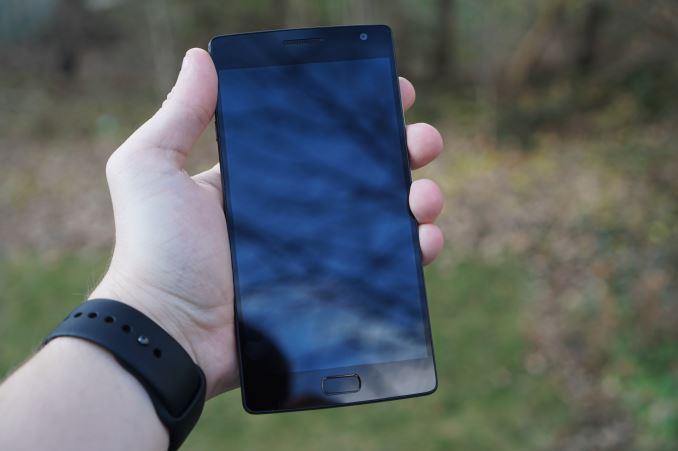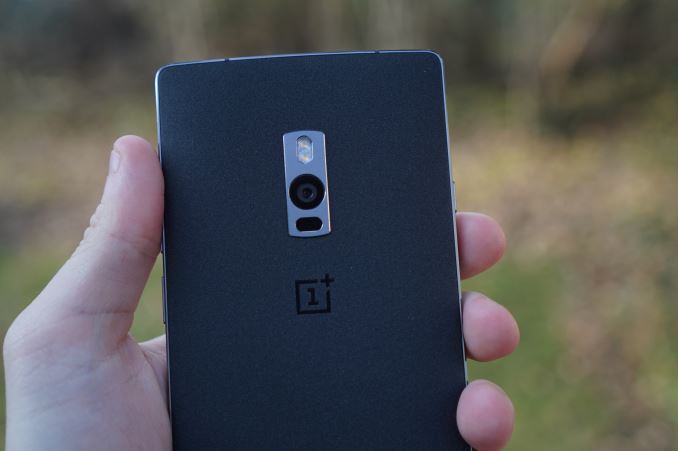The OnePlus 2 Review
by Brandon Chester on December 14, 2015 8:00 AM EST- Posted in
- Smartphones
- Mobile
- OnePlus
- OnePlus 2
Final Words
After using the OnePlus 2 for quite some time and going over the results of my testing, I can't say I'm thrilled with how things turned out for OnePlus's second smartphone. There are a lot of really odd regressions from the original, and when that's accompanied by an increase in price it makes me wonder why someone wouldn't seek out a OnePlus One, or a smartphone from a different vendor entirely. There were definitely some improvements over the OnePlus One as well, some of which are due to the changes in software that have been made since that time. Before making any conclusions, I'd like to go over the major aspects of the OnePlus 2 and see how they hold up to both the OnePlus One, and the rest of the competition in the increasingly competitive smartphone space.
Unfortunately, the OnePlus 2's display was one of the first things I realized represented a regression from the OnePlus One. Right when I started using the phone it was clear that the color rendition was not in line with what I have seen on recent smartphones. Measurements of the display confirmed that it's far too blue, and not accurate beyond matching the primary colors of the sRGB gamut. The substantial changes to the display characteristics that often come with OTA updates never actually improve the display in any meaningful way, and the fact that the accuracy is such an enormous regression from the OnePlus One is just completely unacceptable.
Performance is another area where the OnePlus 2 is extremely disappointing. Snapdragon 810's issues are well documented at this point, but the OnePlus 2 ends up being the worst implementation that I've seen, with the Cortex A57 cores never being used at all in circumstances like web browsing or when navigating the UI. It makes the phone feel like a Moto E, which is something I remarked on before even realizing exactly what was wrong with the CPU's behavior. When considering the performance of the OnePlus 2, it's more accurate to think of it as buying a quad core Cortex A53 device than a 4x4 Cortex A57 + Cortex A53 device.
Thankfully, it's not all bad news. While the performance is certainly not what you'd expect from the advertised specs, the phone gets pretty great battery life as a result. The construction of the phone is also quite good, with very few visible seams due to the type of back cover attachment method OnePlus has used. I'm still not a fan of the back cover material, but I recognize that as a very subjective feeling and so I wouldn't consider that as an aspect that is necessarily positive or negative. As for the camera, OnePlus has put some significant effort into improving their image processing, and there's no longer any issue with chroma noise across the frame even in broad daylight. I think OnePlus still has room to improve in this regard, particularly where noise reduction is concerned, but in its current state the OnePlus 2 produces fairly good photos considering its price tag.
Unfortunately, even with a decent camera, good battery life, and a nice chassis, the OnePlus 2 simply has too many flaws that can't be overlooked. Like the original, the OnePlus 2's tagline is "Never Settle". Unfortunately, the OnePlus 2 does make you settle in many ways. You have to settle for not having Quick Charge 2.0 support, and you have to settle for not having NFC which locks you out of Android Pay. You have to settle for a very poorly calibrated display which pales in comparison to the original. Most disappointing of all is that you have to settle for poor performance, when moving through the UI, browsing the web, and doing anything remotely CPU intensive. You have to settle for a great number of concessions, many of which didn't exist on the OnePlus One, and none of which should exist at this price point.
At $389, you can find much better smartphones, such as the Nexus 5X, or you can search for sales on phones like the Galaxy S6 or LG G4 if you're in a region where the Nexus phones end up being much more expensive than Google's price in North America. Even the OnePlus One would offer a better overall experience. Regardless of what your needs are when buying a smartphone, I think there will be better options available to you than the OnePlus 2.












132 Comments
View All Comments
zeeBomb - Tuesday, December 15, 2015 - link
Wow. Boeffla better than AK? Or both have their strengths & weaknesses...dunno why OP will just shutdown 2 A57s and render it as a 6 core device :/Does it get reaaaly hot on everyday usage too?
fguerro - Tuesday, December 15, 2015 - link
I don't notice the phone getting significantly hotter with the changes in the Boeffla kernel.fguerro - Monday, December 14, 2015 - link
With my OnePlus 2 and custom kernel, running Chrome:Kraken 1.1 = 4419.8ms
Google Octane = 8016
WebXPRT 2015 = 118
MarcSP - Monday, December 14, 2015 - link
Absolutely agree with you.MarcSP - Monday, December 14, 2015 - link
So you review "random" Android devices, but do not review the flagship device of the third mobile platform?And please don't say "2% marketshare worlwide". First, in many countries in Europe it has more than 10%, even more than iPhone. Second, products should be reviewed by relevance, not only marketshare. I think a flasgship phone for one of the major tech companies in the world, with the most used OS (in this case mobile version) is quite relevant.
I am specially interested in the screen: some reviewers said "washed out" and others "very accurate colors". I assume the first group are the ones that like TV sets in the store, with over the top colors and contrast, but I would prefer to see Anandtech numbers to make sure :).
Brandon Chester - Monday, December 14, 2015 - link
Microsoft and their PR agencies have not found a way to send a non-AT&T branded and locked unit to Brett. Might be worth petitioning them to figure that situation out.Vishalaestro - Monday, December 14, 2015 - link
you guys need to review the Asus zenfone 2 laser for the fact that how important the ISP is for camera performance , the camera is night and day better than the Asus zenfone 2 with the intel chipsets.zeeBomb - Tuesday, December 15, 2015 - link
Honestly its just a lot faster to snap, and yeah images are marginally better.LiverpoolFC5903 - Tuesday, December 15, 2015 - link
Quick question from a n00b. I thought the 4 A57 cores are synchronous, as in all four run at the same frequency when active or none at all. Same with the A53 cluster to my knowledge. But your statement about two A57 cores running with two of them shut sort of contradicts that.I also use Treqn profiler app from Qualcom to study CPU performance for different workloads and I have noticed that all four A57 cores show the same frequency curve when mapping CPU use in a graph.
Anyone?
So how does it work?
"For example, in this case the Cortex A57 cores are in use during the web test, while in general they never get used at all during web browsing, and in more intensive situations the best case is that there are two A57 cores in use at some frequency and the other two are shut off."
Andrei Frumusanu - Tuesday, December 15, 2015 - link
Frequency is independent from power states, cores can be shut off or power gated in idle even if the cluster frequency is high.